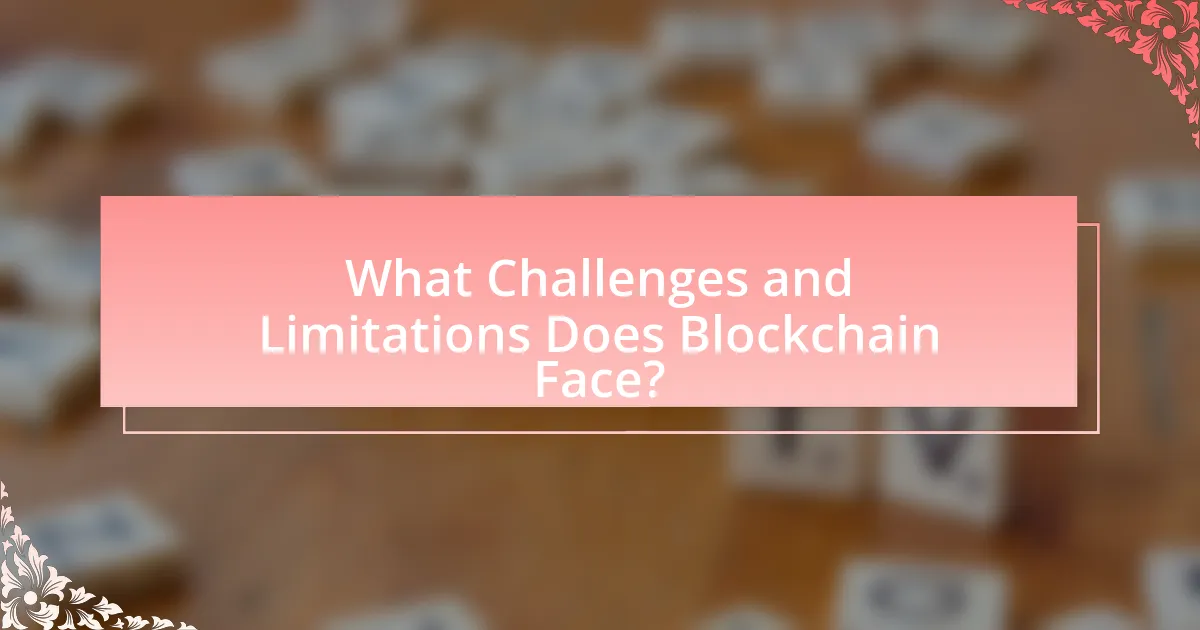Blockchain is a decentralized digital ledger technology that extends beyond its initial association with cryptocurrency, offering secure, transparent, and tamper-proof record-keeping across various industries. This article explores the diverse applications of blockchain, including its role in supply chain management, healthcare, and voting systems, highlighting its key components such as decentralization, immutability, and consensus mechanisms. Additionally, it addresses the challenges and limitations blockchain faces, including scalability and regulatory hurdles, while proposing solutions to enhance its adoption and effectiveness in real-world scenarios. The transformative potential of blockchain technology is underscored by its ability to improve efficiency, security, and transparency across multiple sectors.

What is Blockchain Beyond Cryptocurrency?
Blockchain is a decentralized digital ledger technology that extends beyond cryptocurrency by enabling secure, transparent, and tamper-proof record-keeping across various industries. This technology facilitates applications such as supply chain management, where it enhances traceability and accountability by allowing all parties to access a single source of truth regarding product origins and movements. Additionally, in healthcare, blockchain can securely store patient records, ensuring privacy while allowing authorized access to medical history, which improves care coordination. According to a report by the World Economic Forum, blockchain could potentially add $1.76 trillion to the global economy by 2030 through its applications in sectors like finance, logistics, and governance.
How does blockchain technology function outside of cryptocurrency?
Blockchain technology functions outside of cryptocurrency by providing a decentralized and secure method for recording and verifying transactions across various industries. For instance, in supply chain management, blockchain enhances transparency and traceability by allowing all parties to access a shared ledger that records the movement of goods in real-time. This application reduces fraud and errors, as evidenced by companies like IBM and Walmart using blockchain to track food products, which has improved food safety and reduced waste.
In healthcare, blockchain facilitates secure sharing of patient records among providers while maintaining patient privacy, as demonstrated by initiatives like MedRec, which allows patients to control their health data. Additionally, in voting systems, blockchain can ensure the integrity of elections by providing a tamper-proof record of votes, as seen in pilot projects in various jurisdictions.
These examples illustrate that blockchain’s core attributes—decentralization, security, and transparency—enable its application beyond cryptocurrency, impacting sectors such as supply chain, healthcare, and governance.
What are the key components of blockchain technology?
The key components of blockchain technology are decentralization, immutability, transparency, and consensus mechanisms. Decentralization ensures that no single entity controls the entire network, allowing for distributed data storage across multiple nodes. Immutability refers to the inability to alter or delete data once it has been recorded on the blockchain, which enhances security and trust. Transparency allows all participants to view the transaction history, fostering accountability. Consensus mechanisms, such as Proof of Work or Proof of Stake, are protocols that validate transactions and maintain the integrity of the blockchain. These components collectively enable secure, efficient, and trustworthy transactions in various applications beyond cryptocurrency.
How do these components interact to create a decentralized system?
Decentralized systems are created through the interaction of components such as nodes, consensus mechanisms, and distributed ledgers. Nodes, which are individual devices or computers, communicate with each other to validate transactions and maintain a shared database. Consensus mechanisms, like Proof of Work or Proof of Stake, ensure that all nodes agree on the state of the ledger, preventing any single entity from controlling the network. Distributed ledgers store data across multiple locations, enhancing security and transparency by making it difficult for any one party to alter the information without consensus from the network. This interaction fosters trust and resilience, as the failure of one node does not compromise the entire system, exemplified by Bitcoin’s network, which has operated securely since its inception in 2009.
Why is blockchain considered a revolutionary technology?
Blockchain is considered a revolutionary technology because it enables decentralized, secure, and transparent transactions without the need for intermediaries. This technology utilizes a distributed ledger system, where data is stored across multiple nodes, ensuring that no single entity has control over the entire network. The immutability of blockchain records, achieved through cryptographic hashing, enhances security and trust, as altering any information would require consensus from the majority of the network participants. Additionally, blockchain’s ability to facilitate smart contracts automates processes and reduces costs, further demonstrating its transformative potential across various industries, including finance, supply chain, and healthcare.
What advantages does blockchain offer over traditional systems?
Blockchain offers enhanced security, transparency, and efficiency over traditional systems. Its decentralized nature reduces the risk of data tampering, as each transaction is recorded across multiple nodes, making it nearly impossible to alter past records without consensus. Additionally, blockchain provides real-time visibility into transactions, allowing all parties to verify and audit data independently, which increases trust among users. According to a report by the World Economic Forum, blockchain technology could reduce transaction costs by up to 40% in certain sectors, demonstrating its potential for operational efficiency compared to conventional systems.
How does blockchain enhance security and transparency?
Blockchain enhances security and transparency by utilizing a decentralized ledger system that records transactions in an immutable manner. Each transaction is encrypted and linked to the previous one, creating a chain that is nearly impossible to alter without consensus from the network participants. This structure ensures that once data is recorded, it cannot be changed or deleted, which significantly reduces the risk of fraud and unauthorized access.
Moreover, the transparency of blockchain is achieved through its public nature, where all participants can view the transaction history. This visibility fosters trust among users, as they can independently verify transactions without relying on a central authority. According to a study by the World Economic Forum, blockchain technology can reduce fraud by up to 80% in certain applications, demonstrating its effectiveness in enhancing security and transparency in various sectors beyond cryptocurrency.

What are the Real-World Applications of Blockchain?
Blockchain technology has several real-world applications across various sectors. In supply chain management, blockchain enhances transparency and traceability, allowing companies to track products from origin to consumer, thereby reducing fraud and improving efficiency. For instance, Walmart uses blockchain to trace the source of food products, which has significantly reduced the time needed to track produce from six days to mere seconds.
In the financial sector, blockchain facilitates secure and efficient cross-border payments, reducing transaction costs and times. Ripple, for example, enables real-time international money transfers, which traditional banking systems struggle to achieve.
Healthcare also benefits from blockchain by securely storing patient records, ensuring data integrity, and enabling interoperability among different healthcare providers. The MediLedger Project exemplifies this by allowing pharmaceutical companies to track drug supply chains and combat counterfeit medications.
Additionally, blockchain is utilized in voting systems to enhance security and transparency, as seen in initiatives like Voatz, which allows for secure mobile voting in elections.
These applications demonstrate blockchain’s potential to revolutionize various industries by improving transparency, security, and efficiency.
How is blockchain being utilized in various industries?
Blockchain is being utilized in various industries to enhance transparency, security, and efficiency. In supply chain management, companies like IBM and Maersk use blockchain to track goods in real-time, reducing fraud and improving traceability. In healthcare, blockchain facilitates secure sharing of patient records among providers, ensuring data integrity and compliance with regulations. The financial sector employs blockchain for cross-border payments, significantly lowering transaction costs and processing times, as evidenced by Ripple’s partnerships with major banks. Additionally, the energy sector leverages blockchain for decentralized energy trading, allowing consumers to buy and sell excess energy directly, as seen in projects like Power Ledger. These applications demonstrate blockchain’s transformative potential across multiple sectors.
What role does blockchain play in supply chain management?
Blockchain enhances supply chain management by providing transparency, traceability, and security. It allows all parties involved in the supply chain to access a shared, immutable ledger that records every transaction, ensuring that data is accurate and up-to-date. For instance, according to a report by the World Economic Forum, blockchain can reduce supply chain fraud by up to 50% and improve inventory management efficiency by 20%. This technology enables real-time tracking of goods, which helps in identifying bottlenecks and improving overall operational efficiency.
How is blockchain transforming healthcare data management?
Blockchain is transforming healthcare data management by providing a secure, decentralized platform for storing and sharing patient information. This technology enhances data integrity and security, as each transaction is recorded in an immutable ledger, reducing the risk of data breaches and unauthorized access. For instance, a study published in the Journal of Medical Internet Research highlights that blockchain can improve patient consent management and streamline data sharing among healthcare providers, leading to better patient outcomes and more efficient care delivery.
What are some innovative use cases of blockchain technology?
Innovative use cases of blockchain technology include supply chain management, healthcare data management, and digital identity verification. In supply chain management, blockchain enhances transparency and traceability, allowing stakeholders to track products from origin to consumer, which reduces fraud and improves efficiency. For instance, IBM’s Food Trust platform utilizes blockchain to trace food products, ensuring safety and quality. In healthcare, blockchain secures patient data and enables interoperability among providers, as demonstrated by initiatives like MedRec, which allows patients to control their health records while ensuring privacy. Additionally, digital identity verification through blockchain, such as the Self-Sovereign Identity model, empowers individuals to manage their identities securely, reducing identity theft and fraud. These applications illustrate blockchain’s potential to transform various industries beyond cryptocurrency.
How is blockchain being used in voting systems?
Blockchain is being used in voting systems to enhance security, transparency, and trust in the electoral process. By utilizing blockchain technology, votes can be recorded as immutable entries on a decentralized ledger, which prevents tampering and fraud. For instance, in 2020, Utah County in the United States implemented a blockchain-based voting system that allowed overseas voters to securely cast their ballots, demonstrating the practical application of this technology in real-world elections. This system ensures that each vote is verifiable and traceable, thereby increasing voter confidence and participation.
What impact does blockchain have on intellectual property rights?
Blockchain significantly enhances intellectual property rights by providing a secure, transparent, and immutable ledger for recording ownership and transactions. This technology allows creators to register their works on a blockchain, establishing proof of ownership that is easily verifiable and resistant to tampering. For instance, the use of blockchain in the art world has enabled artists to tokenize their works as non-fungible tokens (NFTs), ensuring that their rights are protected and that they receive royalties from future sales. According to a report by the World Intellectual Property Organization (WIPO), blockchain can streamline the process of licensing and enforcing intellectual property rights, reducing disputes and enhancing trust among stakeholders.

What Challenges and Limitations Does Blockchain Face?
Blockchain faces several challenges and limitations, including scalability, energy consumption, regulatory uncertainty, and interoperability. Scalability issues arise as blockchain networks struggle to process a high volume of transactions quickly; for instance, Bitcoin can handle only about seven transactions per second, while Visa processes thousands. Energy consumption is significant, particularly in proof-of-work systems, with Bitcoin mining estimated to consume as much energy as some small countries. Regulatory uncertainty hampers widespread adoption, as governments grapple with how to classify and regulate blockchain technologies. Lastly, interoperability between different blockchain systems remains a challenge, as many blockchains operate in silos, limiting their ability to communicate and share data effectively.
What are the main obstacles to widespread blockchain adoption?
The main obstacles to widespread blockchain adoption include scalability issues, regulatory uncertainty, and lack of interoperability. Scalability challenges arise as blockchain networks struggle to handle a high volume of transactions efficiently; for instance, Bitcoin can process only about seven transactions per second, compared to thousands for traditional payment systems. Regulatory uncertainty stems from varying legal frameworks across jurisdictions, which can hinder innovation and investment; a report by the World Economic Forum highlights that unclear regulations can deter businesses from adopting blockchain technology. Lastly, lack of interoperability between different blockchain platforms limits their usability and integration into existing systems, as many organizations require seamless communication across various technologies.
How do scalability issues affect blockchain applications?
Scalability issues significantly hinder blockchain applications by limiting transaction throughput and increasing latency. For instance, Bitcoin can process approximately 7 transactions per second, while Ethereum handles around 30, which is insufficient for large-scale applications like supply chain management or financial services that require high transaction volumes. Consequently, these limitations can lead to slower confirmation times and higher transaction fees during peak usage, ultimately affecting user experience and adoption rates. Studies, such as those conducted by the Ethereum Foundation, highlight that scalability solutions like sharding and layer-2 protocols are essential for enhancing performance and enabling broader use cases in real-world applications.
What regulatory challenges does blockchain encounter?
Blockchain encounters several regulatory challenges, primarily due to its decentralized nature and the lack of a unified legal framework. Governments struggle to classify blockchain technology and its applications, leading to inconsistent regulations across jurisdictions. For instance, issues arise regarding data privacy, as regulations like the General Data Protection Regulation (GDPR) in Europe impose strict rules on data handling that conflict with blockchain’s immutable ledger feature. Additionally, the anonymity associated with blockchain transactions raises concerns about money laundering and fraud, prompting regulators to seek compliance measures that can hinder innovation. These challenges highlight the need for a balanced regulatory approach that fosters technological advancement while ensuring consumer protection and legal compliance.
How can these challenges be addressed?
To address the challenges of implementing blockchain technology in real-world applications, stakeholders must focus on enhancing scalability, improving regulatory frameworks, and fostering interoperability. Enhancing scalability can be achieved through the development of layer-2 solutions, such as the Lightning Network, which allows for faster transactions without congesting the main blockchain. Improving regulatory frameworks involves collaboration between governments and industry leaders to create clear guidelines that promote innovation while ensuring consumer protection. Fostering interoperability requires the establishment of standards that enable different blockchain systems to communicate effectively, as seen in initiatives like the Interledger Protocol. These strategies collectively contribute to overcoming the barriers faced by blockchain technology in various sectors.
What solutions are being proposed to improve blockchain scalability?
Proposed solutions to improve blockchain scalability include sharding, layer 2 solutions, and consensus mechanism enhancements. Sharding divides the blockchain network into smaller, manageable pieces, allowing for parallel processing of transactions, which significantly increases throughput. Layer 2 solutions, such as the Lightning Network for Bitcoin and Plasma for Ethereum, enable off-chain transactions that reduce the load on the main blockchain, thereby enhancing scalability. Additionally, improvements in consensus mechanisms, like transitioning from proof-of-work to proof-of-stake, can lead to faster transaction validation and reduced energy consumption, further supporting scalability. These approaches are supported by ongoing research and development in the blockchain community, demonstrating their potential effectiveness in addressing scalability challenges.
How can regulatory frameworks evolve to support blockchain innovation?
Regulatory frameworks can evolve to support blockchain innovation by adopting a flexible and adaptive approach that encourages experimentation while ensuring consumer protection and compliance. This evolution can be achieved through the establishment of regulatory sandboxes, which allow blockchain projects to operate in a controlled environment with reduced regulatory burdens, fostering innovation and collaboration between regulators and developers. For instance, the Financial Conduct Authority in the UK has successfully implemented a regulatory sandbox that has enabled numerous blockchain startups to test their solutions while receiving guidance on compliance. Additionally, creating clear guidelines that define the legal status of blockchain technologies and digital assets can help reduce uncertainty, encouraging investment and development in the sector. Countries like Switzerland have already set a precedent by providing a comprehensive legal framework that supports blockchain initiatives, demonstrating that regulatory clarity can lead to increased adoption and innovation.
What are the best practices for implementing blockchain solutions?
The best practices for implementing blockchain solutions include defining clear objectives, selecting the appropriate blockchain type, ensuring data privacy and security, and fostering collaboration among stakeholders. Clear objectives guide the development process, ensuring that the solution meets specific business needs. Choosing the right blockchain type—public, private, or consortium—affects scalability, security, and governance. Data privacy and security measures, such as encryption and access controls, protect sensitive information and maintain trust. Collaboration among stakeholders, including developers, users, and regulators, enhances the solution’s effectiveness and adoption. These practices are supported by industry reports, such as the “Blockchain Technology Market Report” by MarketsandMarkets, which highlights the importance of strategic planning and stakeholder engagement in successful blockchain implementations.


